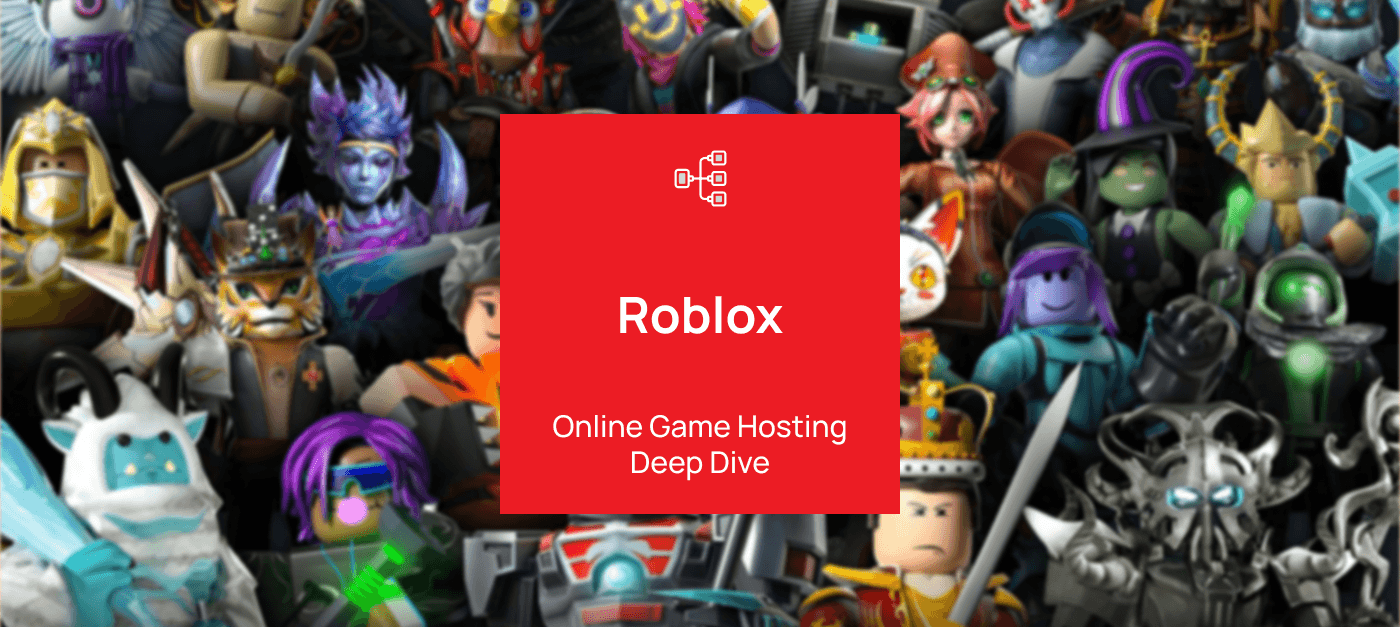
Multiplayer Game Deep Dive - Introducing Backend Concepts through Roblox
Nov 14, 2023
Roblox isn't just another game on the market; it's a colossal universe of user-generated games, all interconnected through a single platform.
Launched in 2004 by David Baszucki and Erik Cassel, Roblox has since evolved into a vast community of creators and players where anyone can design, share, and monetize their game creations. As of today, Roblox boasts millions of user-generated games, making it a unique and influential player in the online gaming industry. Arguably, it is the leading “Metaverse” alongside Epic’s Fortnite.
But what's the magic behind Roblox's seamless world of virtual experiences? As we peel back the layers of Roblox’s user interface and mechanics, the importance of understanding its game backend becomes increasingly apparent.
For aspiring developers, this knowledge empowers them to optimize their games and enhance player experiences. Knowledge that is critical given the well-established high price of poor performance, driven by user backlash or reviews, for online games is player churn – leaving your game empty, and directly impacting your level of success and associated revenues.
What is a Game Backend?
At its core, the game backend can be likened to the backstage crew in a theater performance. While the audience (or players) only witness the actors and the set (the game's frontend), it's the backend that ensures the lights are on, the props are in place, and the sound runs smoothly.
A game server or backend, in technical terms, is responsible for the logic, data storage, and communication aspects of a game. This encompasses player data, game state, leaderboards, virtual item inventories, and more. It's the backbone that ensures consistency, fairness, and functionality in the gaming world.
But how does this differ from the frontend? Think of the frontend as everything you see and interact with directly in the game – the graphics, characters, buttons, and more. It's the user's direct touchpoint. In contrast, the backend does its work behind the scenes, managing data, handling requests, and communicating between players and databases. It recreates the virtual space, and make sure to communicate to each party what the reality of this virtual space is. Both are crucial, but while the frontend is about immediate interaction and presentation, the backend is about processing, storage, and communication.
Roblox’s Unique Platform Model
Roblox stands out not just as a gaming platform but also as a canvas for creation. While traditional games offer a fixed gaming experience, Roblox transcends this norm by providing tools that enable users to create their own virtual realms. Essentially, it's both a game and a game-creation platform.
Young developers, some in their early teens, have found success by designing and monetizing games on Roblox. This democratization of game development highlights Roblox's core philosophy – believing that everyone can be a creator. Through this, Roblox has successfully cultivated a vast ecosystem of user-generated games, each showcasing the boundless imagination of its community.
Roblox Server Architecture
Roblox's massive scale and real-time interactions demand a robust infrastructure. Enter its cloud-based model. By leveraging the cloud, Roblox ensures scalability, accommodating millions of concurrent players without performance degradation. This infrastructure choice is vital, considering the unpredictable popularity spikes of user-generated games. At the heart of this system is the Roblox client-server model.
When players choose a game, the Roblox client – installed on the user's device – communicates with Roblox's servers, establishing a game instance. Within this realm, data synchronization is paramount. As players interact, build, or compete, data changes are seamlessly communicated back and forth between the client and server. This continuous data exchange guarantees that every player's experience remains consistent and immersive, regardless of where they are in the world. Roblox leverages containers (like Edgegap!) to scale dynamically with player’s traffic. They manage over 170,000 containers on top of 18,000 servers, making their architecture a “monster” among the gaming community. They could not do what they do by using the old-style game server model, based on managing fleets and bare metal servers.
Roblox’s Data Store System
At the heart of any online gaming experience lies the challenge of data persistence: ensuring that players’ progress, achievements, and virtual items are consistently and reliably stored. Roblox's answer to this is its Data Store System. It offers various types of data storage solutions tailored to developers' needs. The Ordered Data Store is designed for use cases requiring sorted data, like leaderboards.
Meanwhile, the Global Data Store serves as a general-purpose storage system, ideal for saving player progress or inventory. However, with vast amounts of user-generated content and millions of players, data safety becomes paramount. Roblox employs redundancy and backup measures, ensuring that even in the event of unforeseen hitches, player data remains secure and intact, thereby safeguarding both player trust and game integrity.
Network Communication in Roblox
The beauty of Roblox lies in its real time, interactive experiences. Behind the scenes, this necessitates intricate network communication protocols. Handling real-time player interactions is no small feat; it demands the seamless transmission of vast amounts of data to ensure every jump, chat, or trade happens in the blink of an eye.
This is where latency, the delay before a transfer of data begins, comes into the picture. Minimizing latency is crucial for Roblox, and they achieve this by optimizing their server locations and streamlining data packet transmissions. But it's not just about speed; security is equally vital. Cheating or exploiting can mar the gaming experience. To counter this, Roblox has implemented rigorous security measures, from encrypted data transmissions to sophisticated algorithms that detect abnormal player behaviors, ensuring a fair and fun environment for all.
Roblox’s Backend Scalability
Roblox's success means accommodating millions of concurrent players, a task that demands impeccable backend scalability. This scalability is achieved through dynamic scaling; as games surge in popularity, resources are dynamically allocated to meet demand, ensuring smooth gameplay. Conversely, less frequented games receive proportionately fewer resources, optimizing efficiency.
Central to this system are Roblox's global data centers. Strategically placed around the world, these data centers reduce latency by connecting players to the nearest server. By intelligently distributing game instances based on demand and geographical location, Roblox ensures consistent, lag-free experiences for its vast player base.
Even the Best Can Make Mistake
At the end of October 2021, Roblox suffered a major service outage which brought down their entire platform for over 3 days. The loss of revenue was probably in the tens of millions of dollars. It is crazy to consider that such a large and experienced team created a platform with such a flaw, even worst that it took more than 3 days to get back on track. Sh*t happens, and it can happen to anyone, even the most advanced team. Thinking your team won’t be impacted by this, or will never have to suffer such failure, is like putting your head in the sand.
Challenges and Solutions
No behemoth platform like Roblox is without its challenges. Managing colossal amounts of user-generated content requires rigorous backend operations. Add to that the critical task of ensuring near-perfect uptime and peak performance. These challenges can sometimes strain Roblox's infrastructure. However, Roblox has consistently risen to the occasion.
Their approach involves continuous platform upgrades, using advanced monitoring tools to preemptively identify and rectify potential bottlenecks. Additionally, they employ dedicated teams to oversee server health and address any arising issues swiftly. Through a combination of foresight, innovation, and swift response mechanisms, Roblox ensures that both developers and players enjoy an uninterrupted, high-quality experience.
Roblox raises the bar for all games by making it the reference to players of what online games should be in terms of quality and seamless experience.
However, not all developers have the massive development resources and astronomical amounts of money to build at this level. This is why platforms such as Edgegap, who specialize in backend development, gives a chance to developers of all levels of expertise by enabling them to use the same tools and services available to billion-dollar companies like Roblox.
Best of all, the free tier makes development, well, free. When your game is ready to launch, pay only when your players pay – helping you avoid fixed fees, so you pay only when your game succeeds.
Conclusion
Roblox's meteoric rise in the gaming world is not solely due to its unique platform model but is equally anchored in its sophisticated backend structure. This intricate architecture ensures that millions can create, share, and play seamlessly, all in real time. As we've unveiled the gears that power Roblox's vast universe, it becomes clear that innovation and scalability lie at its core.
Roblox’s limitless possibilities are impossible to replicate by yourself. That’s why it’s dangerous to go alone, and taking the platform like Edgegap offers is critical when building an online game.














